Active LED: Audiovisual technology can be challenging for end-users to navigate. Enterprises and end users face several bottlenecks that can deter their efficiency and growth.
- Correct application of expertise: AV technology and technicians are required for effective maintenance and management and the operation of technology. Due to incorrect or missing application of knowledge, there are instances of redundancies in large-scale solutions for enterprises. AV technologies call for expertise and the correct application of knowledge. While seemingly trivial, complex and demanding requirements require technicians and individuals who can only work with advanced AV infrastructure, it becomes a requirement as applications of AV technology increase in complexity and scale—the requirements for audio and visual conferencing.
Audiovisual technician/audiovisual manager is a position of responsibility for enterprise AV.- Missing scalability: AV technology may be comprehensively stocked in inventory, yet scalability may not exist due to a lack of integration within the enterprise. Considering networking and integration, centralization of audiovisual devices and systems is crucial to enable scalability. AV technology integration enables scalability via reducing complexity, central management and operations control, and cost efficiency. As AV systems are complex, the management systems can allow large-scale integration. An example of these technologies is video conferencing solutions.
- Comprehensive audiovisual management solutions: Using technology from several specialised, localised vendors may cause the enterprise to lack the comprehensive solutions for audiovisual management for enterprise.
- Maintenance of audiovisual architecture: The maintenance of AV architecture incorporates elements of maintenance, scheduling, and integration with facilities’ management systems. Acquiring the requisite maintenance programs for an enterprise’s life cycle in AV can pose a challenge. Technology such as indoor LED tends to be hardy and requires little intervention and management. Yet, overall maintenance of large-scale audiovisual architecture may require comprehensive approaches.
- Lack of centralization for AV architecture: Enterprises operating without centralising AV solutions may lack efficiency and raise the costs of their operations and processes.
- Cyber and physical security vulnerability: Overall, AV systems in enterprises are vulnerable to vast categories of attacks. The use of cyber and physical security safeguards may often be overlooked, especially in enterprises following outdated security policies and technology.
- Obsolescence: Planning for technological obsolescence may emerge as a challenge for AV in the enterprise—future-proofing technology as diverse and varied as Audiovisual technology can be challenging.
- Adoption among end-users and training: Most innovation and advancement in AV technology often outstrips the end-user’s ability and training to apply, utilise and integrate AV for the enterprise effectively. Thus, adoption among end-users & training, or deficiencies in these areas, may result in problems wherein employees and staff are unable to operate technology, or optimization, integration and larger-scale integration are not achieved to the degrees required by the enterprise.
- Ensuring quality and reliability: Management practices and logistics may not be suited to ensuring quality and reliability to the degree required, resulting in inventory losses and suboptimal use through the exclusion of best practices. Shure conference system: Ideally, AV systems have differing quality and reliability requirements and can be addressed effectively by the enterprise.
Complex technology and integration requirements: AV devices are complex, and their integration requirements, especially for analytics and applications with artificial intelligence, remain demanding. Due to the associated complexity of technology and compatibility, feasibility can be challenging for enterprises.





